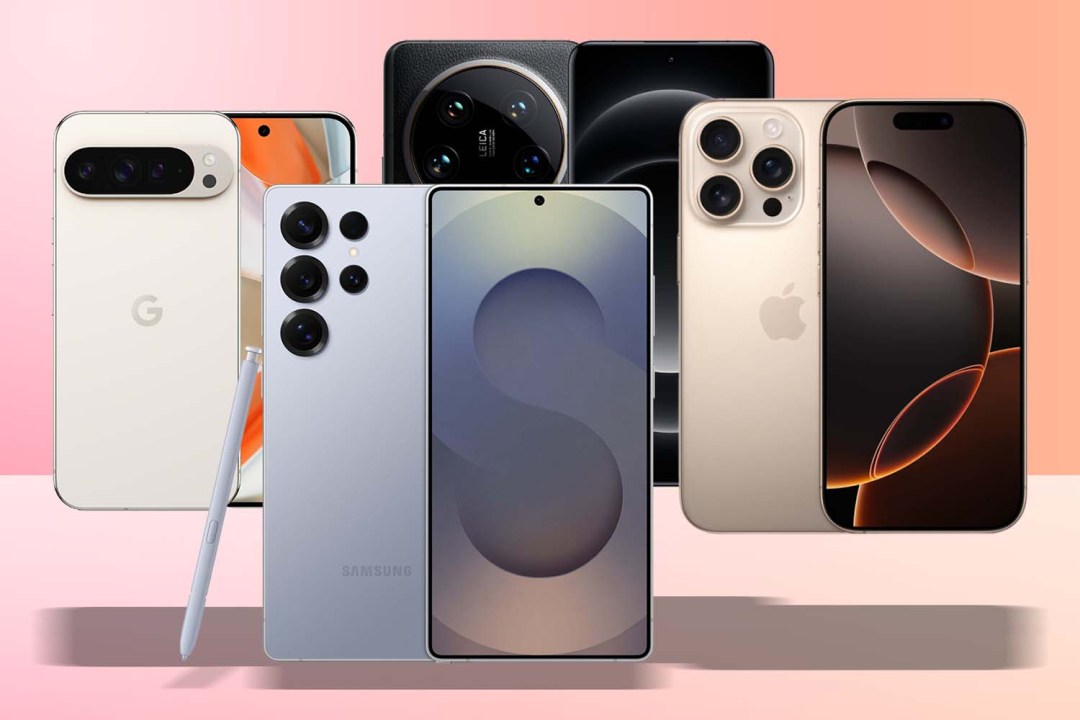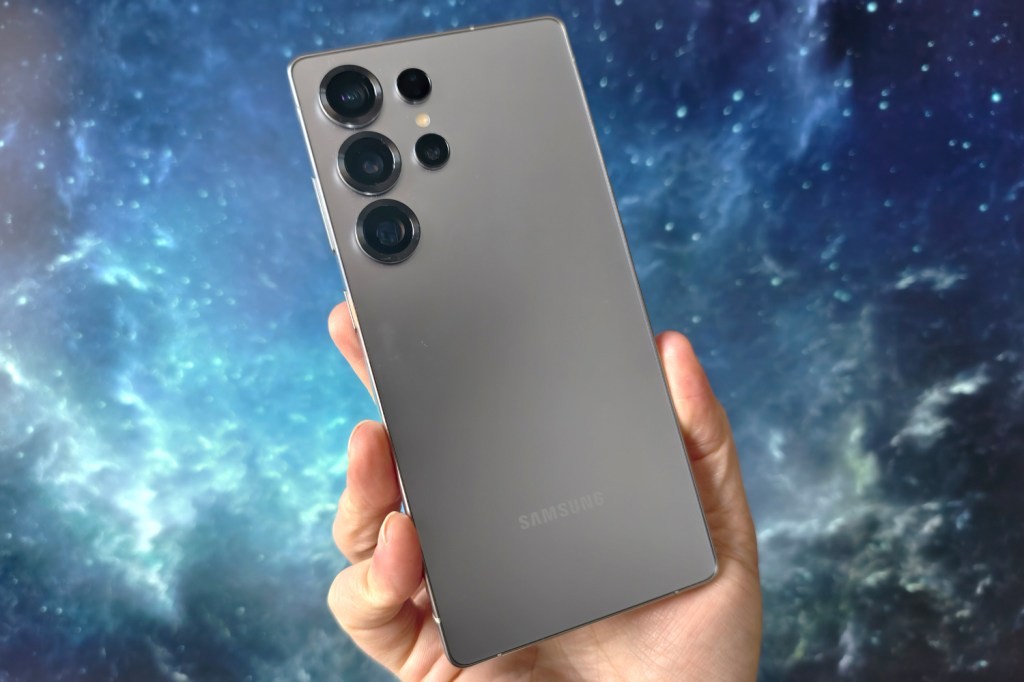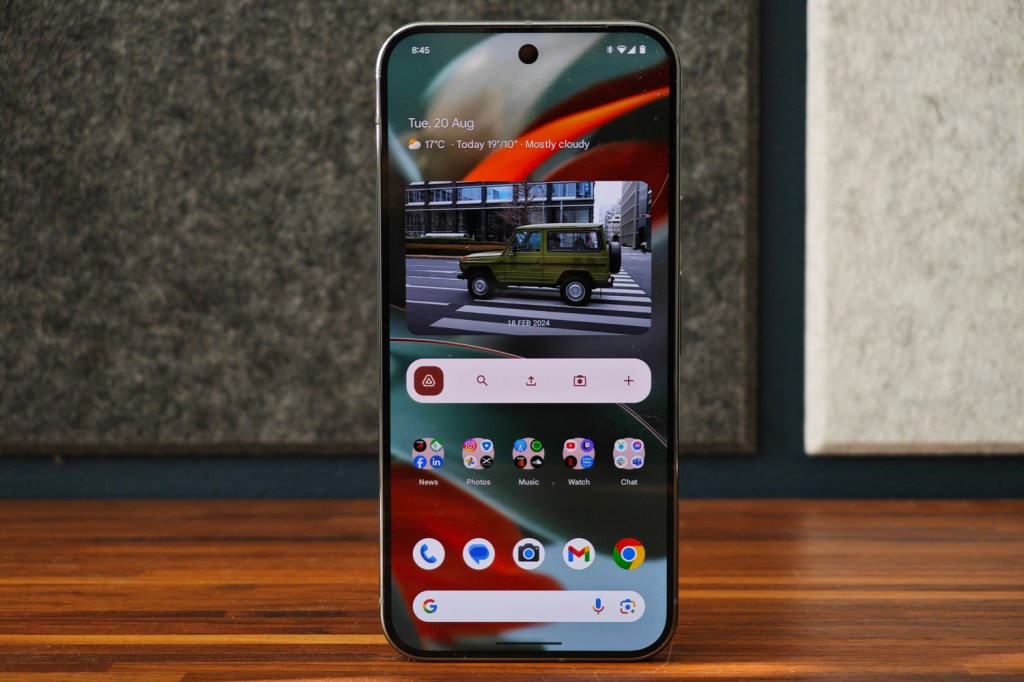Best AI phones 2025: which smartphone has the best AI features?
From the Galaxy S25 Ultra to the Pixel 9 Pro, these are the best phones with AI abilities

Artificial intelligence, or AI, is the phone world’s new favourite buzzword. Almost every upcoming phone has plans to incorporate machine learning and large language models in some form or another, and the first to do so are already on sale. But what are the best AI phones – and the features they bring actually worth having?
I’ve used a bunch of phones with AI on board, and a handful more that offload their AI processing to the cloud. The best AI smartphones have a mix of both. You’ll even find AI cameras and AI image editing on certain flagships. Some use cases are genuinely impressive, and will appeal to most phone owners; others are a lot more niche, and will only be useful to a small minority. These are the models that stand out so far.
The best AI smartphones on sale now:

1. Samsung Galaxy S25 Ultra
Stuff Verdict
Modest hardware changes make it a somewhat disappointing year-on-year upgrade, but there’s no denying the Galaxy S25 Ultra stuffs in ample amounts of AI.
Pros
- AI offerings far more streamlined than previous efforts
- Flagship performance, display and build quality
- Very capable (if not class-leading) cameras
Cons
- AI functions only free for first year
- As expensive as flagship phones get
| Samsung Galaxy S25 Ultra tech specs | |
| Screen | 6.9in, 3200×1440 AMOLED w/ 1-120Hz LTPO adaptive refresh, 2600 nits |
| CPU | Qualcomm Snapdragon 8 Elite For Galaxy |
| Memory | 12GB RAM |
| Storage | 256GB/512GB/1TB on-board |
| Cameras | 200MP, f/1.7 main w/ Quad pixel AF, OIS + 50MP, f/3.4 periscope zoom w/ dual pixel AF, OIS, 5x optical zoom + 10MP, f/2.4 zoom w/ dual pixel AF, OIS, 3x optical zoom + 50MP, f/2.2 ultrawide rear 12MP, f/2.2 front w. dual pixel AF |
| Battery | 5000mAh w/ 45W wired, 15W wireless charging |
| OS | Android 15 w/ OneUI 7 |
| Dimensions | 163x78x8.2mm, 218g |
The corners might be a little rounder and the sides a little flatter, but otherwise the Galaxy S25 Ultra is very similar to last year’s effort. A faster chipset with better cooling, uprated ultrawide camera and tougher, less reflective display glass are the only improvements of note. But given the S24 Ultra was such a fantastic all-rounder, marginal gains are still enough to make this new phone rather desirable indeed.
A Snapdragon 8 Elite For Galaxy CPU provides the performance muscle, with Samsung-specific tweaks that give it the edge over rival flagships. 12GB of RAM and a range of capacity options mean there’s a model out there for everyone. The S Pen stylus is a little more basic this time around, but still comes into its own for note-taking and doodling.
The 200MP main snapper continues to trade blows with the best of ’em, and though the two telephotos aren’t quite class-leaders, they can still bag a pleasant pic. The 50MP ultrawide is a welcome improvement, and adds macro close-up abilities to boot. Samsung hasn’t boosted the 5000mAh battery between generations, but the more efficient CPU helps it last the day on a single charge.
Galaxy S25 Ultra AI features
Galaxy AI, Samsung’s suite of AI-enhanced software, debuted on the Galaxy S24 Ultra, but felt a bit piecemeal; things are a lot more cohesive this year, with shortcuts and OS-wide tools instead of standalone apps. AI Select lives in a pop-out sidebar and lets you highlight text to activate Writing Assist, or images to generatively edit them.
Writing Assist is an evolution of the Chat assist tool baked into the S24 Ultra’s onscreen keyboard. It can create more professional-sounding copy for work, pepper sentences with hashtags for sharing on social media, or sprinkle in emojis for expressive texting. There are also options to summarise longer stretches of text, translate between languages, and check spelling and grammar on the fly.
You’ll also find a transcription summariser built into the voice recorder, which transcribes conversations on the fly (in multiple languages, to boot) and then creates a succinct synopsis in just a few taps. Real-time voice translation, for both phone calls and in person, also relies on AI to give speedy and accurate interpretation. It supports 13 languages at launch, with more expected to follow later.
Now Brief and the Now Bar are all new for 2025. The former is a contextual hub that summarises useful info from your apps. Think sports scores, weather reports, commute traffic and upcoming calendar appointments. The latter simplifies that even further on your lock screen, a bit like Live Activities on iOS.
There’s also Circle to Search; this Google-led tool isn’t exclusive to Samsung phones any more, but it works brilliantly with the S25 Ultra’s S Pen. Press and hold the home button (or gesture bar, if you’re using gesture controls) and draw a circle around anything onscreen. Machine learning recognises objects and locations in a flash, bringing up relevant Google searches – including where to buy the items in question.
Samsung has also added AI to its image editor and photo gallery. It can remove unwanted reflections from glass and shadows from faces with a tap, delete or reposition objects anywhere in the frame, and generationally expand any images you’ve cropped too tightly. The AI camera elements are largely done post-shutter press, rather than before, but object detection does rely on machine learning.
Finally, Instant Slow-mo can create extra frames and inject them into your recorded video footage, creating a convincing effect even if your clips were only shot at 30fps. Just preview your video in the Samsung Gallery app, press and hold on the moment you want slowed down, and it’ll play back brilliantly smoothly.
The best news for owners of older Galaxy phones? Samsung will likely bring most of these AI additions to the Galaxy Z Fold6, Flip6, Galaxy S24 and Galaxy S23 series, meaning you don’t need to upgrade to try them out.
- Read more: Samsung Galaxy S25 Ultra review

2. Google Pixel 9 Pro / XL
Stuff Verdict
Big or small, Google has got you covered for AI. The Pixel 9 Pro duo are outstanding phones that take lovely photos, offer a streamlined take on Android, and have plenty of AI-infused apps.
Pros
- Flagship-worthy build and styling
- Consistently great cameras in all conditions
- Android’s AI upgrades a sign of things to come
Cons
- Measly starting storage
- Higher price makes rivals more tempting
| Google Pixel 9 Pro tech specs | |
| Screen | 6.3in, 1280×2856, 1-120Hz AMOLED (Pro) 6.8in, 2992×1344, 1-120Hz AMOLED (Pro XL) |
| CPU | Google Tensor G4 |
| Memory | 16GB RAM |
| Storage | 128/256/512GB, 1TB on-board |
| Cameras | 50MP, f/1.7 w/ multi-directional PDAF, laser AF, OIS 48MP, f/2.8 telelphoto w/ 5x optical zoom, dual pixel PDAF, OIS 48MP, f/2.0 ultrawide w/ dual pixel PDAF 42MP, f/2.2 front w/ autofocus |
| Battery | 4700mAh (Pro) 5050mAh (Pro XL) |
| OS | Android 14 |
| Dimensions | 152.8x72x8.5mm, 199g (Pro) 163x77x8.5mm, 221g (Pro XL) |
The days of Google’s flagship Pixel phones also being value champions are now long gone, but now they have the high quality build and design to rub shoulders with the equally high-priced competition. Comfortably the best looking Pixel to date, you also now get two size options: the 6.3in Pixel 9 Pro, and the 6.8in Pixel 9 Pro XL.
Both phones have the same excellent rear camera trio, both are powered by a much more efficient Tensor G4 processor, and both can comfortably last all day – though the larger phone does benefit from a much beefier battery capacity. High quality AMOLED screens, Google’s delightfully pared-back take on Android, and one of the best update promises in the business keep them competitive on both hardware and software, while Gemini pushes them to the forefront of AI on phones.
Google Pixel 9 Pro AI features
Google’s AI offering has gone through a couple of names, and just to confuse things further, has multiple versions. Originally known as Bard, it got renamed to Gemini in early 2024. In simple terms, Gemini Pro powers Gemini’s web-based chat interface; Gemini Ultra is more powerful, but not yet open to the public; and Gemini Nano is what’s baked into the Pixel 9 Pro duo.
Right now, its top features include a Summarise function in the voice recorder app. Open any recording, tap the Transcript button, then Summarise at the top; the phone will generate a bullet point synopsis, all on-device.
Smart reply in Gboard uses AI to suggest responses to your WhatsApp, Line, and KakaoTalk chats – but only in US English right now, and as a developer preview. It should start rolling out more widely later this year.
Circle to search is available to everyone, right now. Press and hold the gesture indicator (or onscreen home button if you have it enabled) and draw a circle around any onscreen text or image; your phone will then look it up on Google, using machine learning to recognise objects and locations with impressive speed and accuracy.
The Pixel 9 Pro can also create AI-generated wallpapers. It’s baked into Android 14, so will eventually be added to other manufacturers’ mobiles. You can pick from a bunch of themes, objects, materials and colours, with the phone creating a mix of convincing, surreal and clearly computer generated images.
Naturally for a Pixel phone, the Pixel 9 Pro’s AI focuses heavily on photography. Magic Editor intelligently recognises objects when you tap them, letting you move them around the image – or remove them entirely, with the phone filling in the gaps. The results can be genuinely impressive.
Best Take feels more like clever photo merging than true AI; it relies on you having taken multiple shots of the same scene. You can then tap on each person’s face and swap it out – handy for group shots where one person is blinking or looking away.
Finally, Video Boost sends your recorded video footage off to the Cloud for AI-based processing. It enhances colour and lighting to an impressive degree, but it’s Google’s servers doing all the heavy lifting here, rather than your phone.
- Read more: Google Pixel 9 Pro review

3. Apple iPhone 16 Pro Max
Stuff Verdict
Not an update that makes you want to throw a party, but the iPhone 16 Pro Max’s power, camera and battery life are so good it’s hard to imagine anyone not being quietly impressed.
Pros
- Ludicrously powerful with impressive battery life
- Impressive new camera smarts
- Incorporates AI throughout the OS in ways only Apple can do
Cons
- Now even bigger and bulkier
- Boring colours
The latest and greatest iPhone isn’t a huge departure from what came before, but does expand Apple’s offering with a new Camera Control button that blurs the line between phone and photography. New A18 Pro silicon is undeniably rapid in both apps and games, and the uprated ultrawide camera adds magnificent macro shooting abilities on to what was already one of the best smartphone snapping systems around.
A titanium build, industry-shaping flat frame and Ceramic Shield glass make this one tough cookie, while the ProMotion OLED display is simply gorgeous. Slimmer bezels have boosted total screen size from 6.7in to 6.9in, making this the biggest iPhone yet, without becoming too unwieldy. iOS 18 also brought some design tweaks, a revamped notes app, and long-awaited iPhone mirroring on Mac. But if you’re only interested in AI, it’ll be Apple Intelligence that makes the biggest impact.
iPhone 16 Pro Max AI features
Apple Intelligence admittedly had some teething problems. It didn’t arrive alongside the iPhone 16, and saw a staggered rollout across various territories. Apple had to roll back certain features because they were inaccurate, like the notification summaries that showed false headlines attributed to the BBC and other news sources. But there’s still plenty here to get excited about.
Writing Tools live in a contextual menu and lets you proofread or rewrite text selections or entire documents. It can summarise articles, reformat them into bullet points or tables, and directly call up ChatGPT through its Compose option.
The Photos app now has a Clean Up option similar to Google’s Magic Eraser. It also lets you search for specific pics or clips using natural language, then create Memories animations from the prompts.
Custom emoji can be generated on the fly, while Image Playground creates images in three styles – sketch, illustration, and animation – based on text prompts.
The Notes app can now transcribe recordings, and summarise that transcription for quick reference later. The dialler app can do the same for calls (as long as you live somewhere it’s legal to record phone conversations).
And Siri can now phone a friend for more complex queries, by tapping into ChatGPT – with or without a free or paid OpenAI account.
- Read more: Apple iPhone 16 Pro Max review

4. Xiaomi 14 Ultra
Stuff Verdict
Camera hardware that sets a new bar for phone photography, and a stunning handset in virtually every other aspect.
Pros
- Brilliantly capable quad camera setup
- Outstanding performance
- Photography kit is a must-buy for keen snappers
Cons
- It’s a mighty pricey handset
- Other flagships have slightly better battery life
| Xiaomi 14 Ultra tech specs | |
| Screen | 6.73in, 3200×1440 AMOLED w/ 1-120Hz LTPO, 3000 nits |
| CPU | Qualcomm Snapdragon 8 Gen 3 |
| Memory | 16GB RAM |
| Cameras | 50MP, 23mm, f/1.6-f/4.0 main w/ OIS + 50MP, 12mm, f/1.8 ultrawide w/ macro focus + 50MP, 75mm, f/1.8 telephoto w/ 3x optical zoom, OIS + 50MP, 120mm, f/2.5 telephoto w/ 5x optical zoom, OIS 32MP, f/2.0 front |
| Storage | 512GB on-board |
| Operating system | Android 14 w/ HyperOS |
| Battery | 5000mAh w/ 90W wired, 80W wireless charging |
| Dimensions | 161x75x9.2mm, 229.5g |
Xiaomi’s latest flagship has some of the best photography hardware of any phone – and so it should, given the colossal camera bump at its rear. Leica glass, a 1in lead sensor with variable aperture lens, separate 3x and 5x zoom lenses each with optical image stabilisation, and a macro-capable ultrawide snapper make for impeccable images.
Top-tier internals, including a Snapdragon 8 Gen 3 CPU and a huge 5000mAh battery, keep pace everywhere else. An OLED display then finds the ideal middle ground between flat glass and curved-edge panels.
Xiaomi 14 Ultra AI features
As part of its initial AI efforts, Xiaomi added AI-generated subtitles for video calls. The firm’s Image editor already had object eraser and sky replacement tools, but now these are reported to use AI acceleration. AI audio transcription, voice translation and note summaries all make the grade, too.
The firm also brought an AI portrait feature in an over-the-air update. It can put take your face from a photo and put it into just about any pose, outfit or background you can think of (as long as it’s PG, of course). Generative image expansion also lets you resize images you’ve cropped in on too tightly.
- Read more: Xiaomi 14 Ultra review



